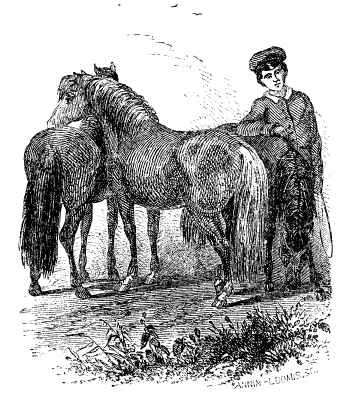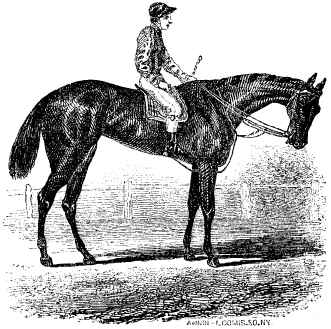SOMETHING ABOUT THE HORSE.
759


but they are really chosen on
account of their docility and gentleness. A black horse, it is said, can
not stand heat; yet the inhabitant of Africa is made expressly black for
that very purpose. The white horse is pronounced unsuited to cold;
yet the polar bear is as colorless as the snows on which he sleeps. The
physiognomy of horses is much regarded—if he is broad and full
between the eyes, he is supposed to have superior sense, and to be easily
trained. “A dish-face”is always unsafe, the dispositions of such horses
being as exceptionable as their looks.
In all ages good horses have
commanded high prices. This is no doubt owing to the fact that a faultless
one is seemingly impossible to obtain, while those of surpassingly good
qualities can hardly be appreciated in money. In our own times we find
that enormous sums are paid for racers. Mr. O'Kelly,
owner of English Eclipse, asked for that celebrated horse twenty-five
thousand pounds and an annuity of five hundred more for
life. We have preserved the prices of horses at two
different periods which are calculated to attract attention. In
Solomon's time, the wholesale price, and under a government contract,
was one hundred and fifty shekels, which, according to Bishop
Cumberland's calculation, is about eighty-seven dollars—a great sum in
those times. In the days of Xenophon, six hundred years later, the price
of a good horse had materially increased, for Seuthes the Thracian
paid to the Persian monarch one hundred and thirty-seven dollars for
the steed which he
rode during his retreat from Babylon. The prices of good horses are
enormous, not only on account of their rarity, but also from their
liability to disease and death. The constitution of no animal seems
to be more subject to derangement than the horse, and consequently the
owner of one of rare qualities is in constant excitement. David the
Psalmist seems to have had the usual experience, for he exclaims, “ A
horse for preservation is but a deceitful thing,” and such has been
their history from time immemorial even unto the present day.
The racing of one horse against
another is
SHETLAND PONIES.
racer, whose back is level with
his rider's eyes. The “Rocky Mountain horse,” called after the vicinity in
which he was captured, and quite recently exhibited in New Orleans, was
the tallest animal of his species ever known, being twenty-one hands
in height (seven feet !), and weighing but little less than his English
rival. An experienced person in raising horses states, that after a colt
is three weeks old, the number of inches which can be measured from the
hair on the hoofs to the middle of the first joint will give the exact
number of hands the colt will reach when full grown: thus, if the length
be fourteen inches, the colt will in due time, if it lives and no
extraordinary accident happens to it, become a horse of fourteen hands in
height. Much importance is attached to the color of horses, particularly
with regard to the legs. The Arabs, with “stockinged horses,” have the
extremes of good and bad luck, according to the disposition of the white.
As senseless as these fancies may appear, they nevertheless influence the
price of the animal, sometimes to even a sixth part of his value. In our
own country, inheriting it from England, this very prejudice about the
color of horses’ legs was as firmly rooted as in benighted Africa.
According to the rhyme,
“ One white foot—buy a horse ;
Two white feet—try a horse ; Three white feet—look well about him ; Four
white feet—go without him.”
The best horses we have ever had
in the United States were marked with white stockings—so was Boston, so is
Lexington, the noblest steed upon the American turf. It is proverbial that
sorrel and chestnut horses with white upon their legs are good-natured,
while the same colors without a dash of white represent tricky and
unsafe animals. Many suppose that the particolored horses
belonging to circuses or performing upon the stage arc selected for
their oddity.

RACE-HORSE AND JOCKEY.